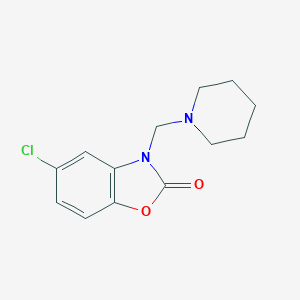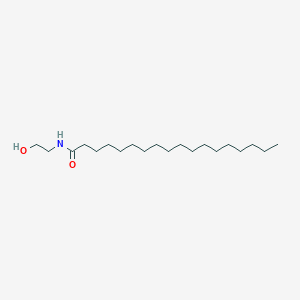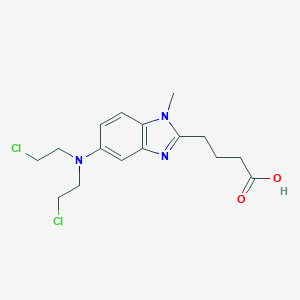
Bendamustine
Übersicht
Beschreibung
Bendamustin ist ein Chemotherapeutikum, das hauptsächlich zur Behandlung von chronisch-lymphatischer Leukämie, multiplem Myelom und Non-Hodgkin-Lymphom eingesetzt wird . Es gehört zur Klasse der alkylierenden Agenzien und wirkt, indem es die Funktion von DNA und RNA stört, was zum Zelltod führt . Bendamustin wurde erstmals Anfang der 1960er Jahre in der DDR synthetisiert und 2008 in den Vereinigten Staaten für die medizinische Verwendung zugelassen .
Vorbereitungsmethoden
Synthesewege und Reaktionsbedingungen: Bendamustinhydrochlorid kann durch einen mehrstufigen Prozess synthetisiert werden. Das Schlüsselzwischenprodukt, 1-Methyl-5-[bis(2-chlorethyl)amino]-1H-benzimidazol-2-yl]lithiumbutanoat, wird hergestellt und dann in Bendamustinhydrochlorid umgewandelt . Der Prozess beinhaltet die Verwendung verschiedener Reagenzien und Lösungsmittel, darunter Trifluoressigsäure und Acetonitril .
Industrielle Produktionsmethoden: Die industrielle Produktion von Bendamustinhydrochlorid zielt auf eine hohe Reinheit (≥99%) ab und umfasst Schritte wie die Hochleistungsflüssigkeitschromatographie (HPLC) zur Reinigung . Der Prozess ist darauf ausgelegt, wirtschaftlich und umweltfreundlich zu sein, wobei die Verwendung gefährlicher Chemikalien vermieden wird .
Analyse Chemischer Reaktionen
Reaktionstypen: Bendamustin unterliegt verschiedenen Arten von chemischen Reaktionen, darunter Alkylierung, Hydrolyse und Oxidation . Als alkylierendes Agens bildet es Intra- und Interstrang-Vernetzungen zwischen DNA-Basen, was zum Zelltod führt .
Häufige Reagenzien und Bedingungen:
Alkylierung: Bendamustin bildet elektrophile Alkylgruppen, die kovalent an DNA-Basen binden.
Hydrolyse: Die Verbindung wird in der Leber zu inaktiven Metaboliten hydrolysiert.
Oxidation: Durch Oxidation entstehen Nebenprodukte wie Gamma-Hydroxy-Bendamustin und N-Desmethyl-Bendamustin.
Hauptprodukte: Zu den Hauptprodukten, die aus diesen Reaktionen gebildet werden, gehören die inaktiven Metaboliten und die vernetzte DNA .
Wissenschaftliche Forschungsanwendungen
Bendamustin hat ein breites Spektrum an Anwendungen in der wissenschaftlichen Forschung:
Industrie: Es wird bei der Entwicklung neuer Chemotherapieregime und Kombinationstherapien eingesetzt.
5. Wirkmechanismus
Bendamustin übt seine Wirkungen durch mehrere Mechanismen aus:
Alkylierung: Es bildet Intra- und Interstrang-Vernetzungen zwischen DNA-Basen, was zum Zelltod führt.
Aktivierung von DNA-Schadensantworten: Bendamustin aktiviert DNA-Schadensstressantworten und Apoptose.
Inhibition von mitotischen Kontrollpunkten: Es inhibiert mitotische Kontrollpunkte und induziert eine mitotische Katastrophe.
Molekulare Ziele: Die Hauptziele sind die DNA-Basen, was zur Störung der DNA-Replikation und -Transkription führt.
Wirkmechanismus
Bendamustine exerts its effects through multiple mechanisms:
Alkylation: It forms intra- and inter-strand crosslinks between DNA bases, leading to cell death.
Activation of DNA-Damage Responses: this compound activates DNA-damage stress responses and apoptosis.
Inhibition of Mitotic Checkpoints: It inhibits mitotic checkpoints and induces mitotic catastrophe.
Molecular Targets: The primary targets are the DNA bases, leading to the disruption of DNA replication and transcription.
Vergleich Mit ähnlichen Verbindungen
Bendamustin ist aufgrund seiner bifunktionalen Natur einzigartig, die Eigenschaften sowohl von alkylierenden Agenzien als auch von Purin-Analoga kombiniert . Zu ähnlichen Verbindungen gehören:
Cyclophosphamid: Ein weiteres alkylierendes Agens, das in der Chemotherapie eingesetzt wird.
Melphalan: Ein alkylierendes Agens, das für das multiple Myelom eingesetzt wird.
Chlorambucil: Wird für die chronisch-lymphatische Leukämie eingesetzt.
Im Vergleich zu diesen Verbindungen hat Bendamustin eine erhöhte Stabilität und ein breiteres Wirkungsspektrum gegen sowohl ruhende als auch sich teilende Zellen gezeigt .
Eigenschaften
IUPAC Name |
4-[5-[bis(2-chloroethyl)amino]-1-methylbenzimidazol-2-yl]butanoic acid | |
|---|---|---|
| Source | PubChem | |
| URL | https://pubchem.ncbi.nlm.nih.gov | |
| Description | Data deposited in or computed by PubChem | |
InChI |
InChI=1S/C16H21Cl2N3O2/c1-20-14-6-5-12(21(9-7-17)10-8-18)11-13(14)19-15(20)3-2-4-16(22)23/h5-6,11H,2-4,7-10H2,1H3,(H,22,23) | |
| Source | PubChem | |
| URL | https://pubchem.ncbi.nlm.nih.gov | |
| Description | Data deposited in or computed by PubChem | |
InChI Key |
YTKUWDBFDASYHO-UHFFFAOYSA-N | |
| Source | PubChem | |
| URL | https://pubchem.ncbi.nlm.nih.gov | |
| Description | Data deposited in or computed by PubChem | |
Canonical SMILES |
CN1C2=C(C=C(C=C2)N(CCCl)CCCl)N=C1CCCC(=O)O | |
| Source | PubChem | |
| URL | https://pubchem.ncbi.nlm.nih.gov | |
| Description | Data deposited in or computed by PubChem | |
Molecular Formula |
C16H21Cl2N3O2 | |
| Source | PubChem | |
| URL | https://pubchem.ncbi.nlm.nih.gov | |
| Description | Data deposited in or computed by PubChem | |
Related CAS |
3543-75-7 (hydrochloride) | |
| Record name | Bendamustine [INN:BAN] | |
| Source | ChemIDplus | |
| URL | https://pubchem.ncbi.nlm.nih.gov/substance/?source=chemidplus&sourceid=0016506277 | |
| Description | ChemIDplus is a free, web search system that provides access to the structure and nomenclature authority files used for the identification of chemical substances cited in National Library of Medicine (NLM) databases, including the TOXNET system. | |
DSSTOX Substance ID |
DTXSID2046888 | |
| Record name | Bendamustine | |
| Source | EPA DSSTox | |
| URL | https://comptox.epa.gov/dashboard/DTXSID2046888 | |
| Description | DSSTox provides a high quality public chemistry resource for supporting improved predictive toxicology. | |
Molecular Weight |
358.3 g/mol | |
| Source | PubChem | |
| URL | https://pubchem.ncbi.nlm.nih.gov | |
| Description | Data deposited in or computed by PubChem | |
Mechanism of Action |
Bendamustine is a bifunctional mechlorethamine derivative capable of forming electrophilic alkyl groups that covalently bond to other molecules. Through this function as an alkylating agent, bendamustine causes intra- and inter-strand crosslinks between DNA bases resulting in cell death. It is active against both active and quiescent cells, although the exact mechanism of action is unknown., Multiple myeloma is a fatal hematological disease caused by malignant transformation of plasma cells. Bendamustine has been proven to be a potent alternative to melphalan in phase 3 studies, yet its molecular mode of action is still poorly understood. The four-myeloma cell lines NCI-H929, OPM-2, RPMI-8226, and U266 were cultured in vitro. Apoptosis was measured by flow cytometry after annexin V FITC and propidium iodide staining. Cell cycle distribution of cells was determined by DNA staining with propidium iodide. Intracellular levels of (phosphorylated) proteins were determined by western blot. /It was shown/ that bendamustine induces apoptosis with an IC50 of 35-65 mug/ml and with cleavage of caspase 3. Incubation with 10-30 mug/ml results in G2 cell cycle arrest in all four-cell lines. The primary DNA-damage signaling kinases ATM and Chk2, but not ATR and Chk1, are activated. The Chk2 substrate Cdc25A phosphatase is degraded and Cdc2 is inhibited by inhibitory phosphorylation of Tyr15 accompanied by increased cyclin B levels. Additionally, p53 activation occurs as phosphorylation of Ser15, the phosphorylation site for ATM. p53 promotes Cdc2 inhibition by upregulation of p21. Targeting of p38 MAPK by the selective inhibitor SB202190 significantly increases bendamustine induced apoptosis. Additionally, SB202190 completely abrogates G2 cell cycle arrest. Bendamustine induces ATM-Chk2-Cdc2-mediated G2 arrest and p53 mediated apoptosis. Inhibition of p38 MAPK augments apoptosis and abrogates G2 arrest and can be considered as a new therapeutic strategy in combination with bendamustine., Microarray-based gene expression profiling, real-time PCR, immunoblot, cell cycle, and functional DNA damage repair analyses were used to characterize response to bendamustine and compare it with chlorambucil and phosphoramide mustard. Bendamustine displays a distinct pattern of activity unrelated to other DNA-alkylating agents. Its mechanisms of action include activation of DNA-damage stress response and apoptosis, inhibition of mitotic checkpoints, and induction of mitotic catastrophe. In addition, unlike other alkylators, bendamustine activates a base excision DNA repair pathway rather than an alkyltransferase DNA repair mechanism. These results suggest that bendamustine possesses mechanistic features that differentiate it from other alkylating agents and may contribute to its distinct clinical efficacy profile., Bendamustine is a bifunctional mechlorethamine derivative containing a purine-like benzimidazole ring. Mechlorethamine and its derivatives form electrophilic alkyl groups. These groups form covalent bonds with electron-rich nucleophilic moieties, resulting in interstrand DNA crosslinks. The bifunctional covalent linkage can lead to cell death via several pathways. Bendamustine is active against both quiescent and dividing cells. The exact mechanism of action of bendamustine remains unknown. | |
| Record name | Bendamustine | |
| Source | DrugBank | |
| URL | https://www.drugbank.ca/drugs/DB06769 | |
| Description | The DrugBank database is a unique bioinformatics and cheminformatics resource that combines detailed drug (i.e. chemical, pharmacological and pharmaceutical) data with comprehensive drug target (i.e. sequence, structure, and pathway) information. | |
| Explanation | Creative Common's Attribution-NonCommercial 4.0 International License (http://creativecommons.org/licenses/by-nc/4.0/legalcode) | |
| Record name | Bendamustine | |
| Source | Hazardous Substances Data Bank (HSDB) | |
| URL | https://pubchem.ncbi.nlm.nih.gov/source/hsdb/7763 | |
| Description | The Hazardous Substances Data Bank (HSDB) is a toxicology database that focuses on the toxicology of potentially hazardous chemicals. It provides information on human exposure, industrial hygiene, emergency handling procedures, environmental fate, regulatory requirements, nanomaterials, and related areas. The information in HSDB has been assessed by a Scientific Review Panel. | |
CAS No. |
16506-27-7 | |
| Record name | Bendamustine | |
| Source | CAS Common Chemistry | |
| URL | https://commonchemistry.cas.org/detail?cas_rn=16506-27-7 | |
| Description | CAS Common Chemistry is an open community resource for accessing chemical information. Nearly 500,000 chemical substances from CAS REGISTRY cover areas of community interest, including common and frequently regulated chemicals, and those relevant to high school and undergraduate chemistry classes. This chemical information, curated by our expert scientists, is provided in alignment with our mission as a division of the American Chemical Society. | |
| Explanation | The data from CAS Common Chemistry is provided under a CC-BY-NC 4.0 license, unless otherwise stated. | |
| Record name | Bendamustine [INN:BAN] | |
| Source | ChemIDplus | |
| URL | https://pubchem.ncbi.nlm.nih.gov/substance/?source=chemidplus&sourceid=0016506277 | |
| Description | ChemIDplus is a free, web search system that provides access to the structure and nomenclature authority files used for the identification of chemical substances cited in National Library of Medicine (NLM) databases, including the TOXNET system. | |
| Record name | Bendamustine | |
| Source | DrugBank | |
| URL | https://www.drugbank.ca/drugs/DB06769 | |
| Description | The DrugBank database is a unique bioinformatics and cheminformatics resource that combines detailed drug (i.e. chemical, pharmacological and pharmaceutical) data with comprehensive drug target (i.e. sequence, structure, and pathway) information. | |
| Explanation | Creative Common's Attribution-NonCommercial 4.0 International License (http://creativecommons.org/licenses/by-nc/4.0/legalcode) | |
| Record name | Bendamustine | |
| Source | EPA DSSTox | |
| URL | https://comptox.epa.gov/dashboard/DTXSID2046888 | |
| Description | DSSTox provides a high quality public chemistry resource for supporting improved predictive toxicology. | |
| Record name | 16506-27-7 | |
| Source | European Chemicals Agency (ECHA) | |
| URL | https://echa.europa.eu/information-on-chemicals | |
| Description | The European Chemicals Agency (ECHA) is an agency of the European Union which is the driving force among regulatory authorities in implementing the EU's groundbreaking chemicals legislation for the benefit of human health and the environment as well as for innovation and competitiveness. | |
| Explanation | Use of the information, documents and data from the ECHA website is subject to the terms and conditions of this Legal Notice, and subject to other binding limitations provided for under applicable law, the information, documents and data made available on the ECHA website may be reproduced, distributed and/or used, totally or in part, for non-commercial purposes provided that ECHA is acknowledged as the source: "Source: European Chemicals Agency, http://echa.europa.eu/". Such acknowledgement must be included in each copy of the material. ECHA permits and encourages organisations and individuals to create links to the ECHA website under the following cumulative conditions: Links can only be made to webpages that provide a link to the Legal Notice page. | |
| Record name | BENDAMUSTINE | |
| Source | FDA Global Substance Registration System (GSRS) | |
| URL | https://gsrs.ncats.nih.gov/ginas/app/beta/substances/9266D9P3PQ | |
| Description | The FDA Global Substance Registration System (GSRS) enables the efficient and accurate exchange of information on what substances are in regulated products. Instead of relying on names, which vary across regulatory domains, countries, and regions, the GSRS knowledge base makes it possible for substances to be defined by standardized, scientific descriptions. | |
| Explanation | Unless otherwise noted, the contents of the FDA website (www.fda.gov), both text and graphics, are not copyrighted. They are in the public domain and may be republished, reprinted and otherwise used freely by anyone without the need to obtain permission from FDA. Credit to the U.S. Food and Drug Administration as the source is appreciated but not required. | |
| Record name | Bendamustine | |
| Source | Hazardous Substances Data Bank (HSDB) | |
| URL | https://pubchem.ncbi.nlm.nih.gov/source/hsdb/7763 | |
| Description | The Hazardous Substances Data Bank (HSDB) is a toxicology database that focuses on the toxicology of potentially hazardous chemicals. It provides information on human exposure, industrial hygiene, emergency handling procedures, environmental fate, regulatory requirements, nanomaterials, and related areas. The information in HSDB has been assessed by a Scientific Review Panel. | |
Retrosynthesis Analysis
AI-Powered Synthesis Planning: Our tool employs the Template_relevance Pistachio, Template_relevance Bkms_metabolic, Template_relevance Pistachio_ringbreaker, Template_relevance Reaxys, Template_relevance Reaxys_biocatalysis model, leveraging a vast database of chemical reactions to predict feasible synthetic routes.
One-Step Synthesis Focus: Specifically designed for one-step synthesis, it provides concise and direct routes for your target compounds, streamlining the synthesis process.
Accurate Predictions: Utilizing the extensive PISTACHIO, BKMS_METABOLIC, PISTACHIO_RINGBREAKER, REAXYS, REAXYS_BIOCATALYSIS database, our tool offers high-accuracy predictions, reflecting the latest in chemical research and data.
Strategy Settings
| Precursor scoring | Relevance Heuristic |
|---|---|
| Min. plausibility | 0.01 |
| Model | Template_relevance |
| Template Set | Pistachio/Bkms_metabolic/Pistachio_ringbreaker/Reaxys/Reaxys_biocatalysis |
| Top-N result to add to graph | 6 |
Feasible Synthetic Routes
Haftungsausschluss und Informationen zu In-Vitro-Forschungsprodukten
Bitte beachten Sie, dass alle Artikel und Produktinformationen, die auf BenchChem präsentiert werden, ausschließlich zu Informationszwecken bestimmt sind. Die auf BenchChem zum Kauf angebotenen Produkte sind speziell für In-vitro-Studien konzipiert, die außerhalb lebender Organismen durchgeführt werden. In-vitro-Studien, abgeleitet von dem lateinischen Begriff "in Glas", beinhalten Experimente, die in kontrollierten Laborumgebungen unter Verwendung von Zellen oder Geweben durchgeführt werden. Es ist wichtig zu beachten, dass diese Produkte nicht als Arzneimittel oder Medikamente eingestuft sind und keine Zulassung der FDA für die Vorbeugung, Behandlung oder Heilung von medizinischen Zuständen, Beschwerden oder Krankheiten erhalten haben. Wir müssen betonen, dass jede Form der körperlichen Einführung dieser Produkte in Menschen oder Tiere gesetzlich strikt untersagt ist. Es ist unerlässlich, sich an diese Richtlinien zu halten, um die Einhaltung rechtlicher und ethischer Standards in Forschung und Experiment zu gewährleisten.


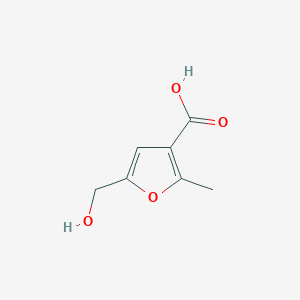
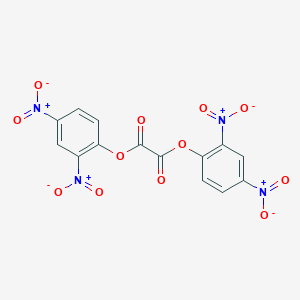
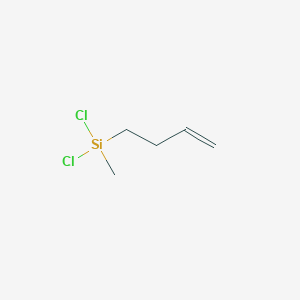
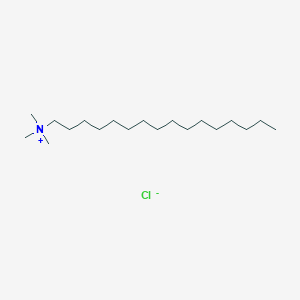
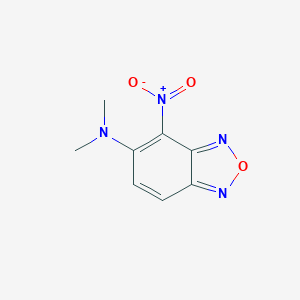
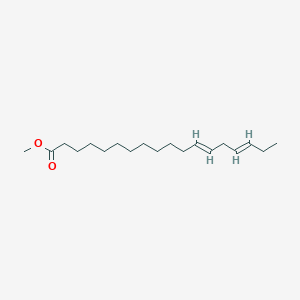

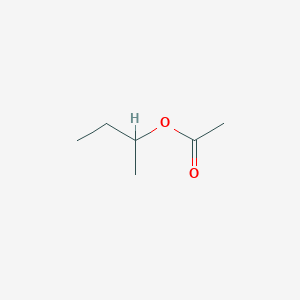
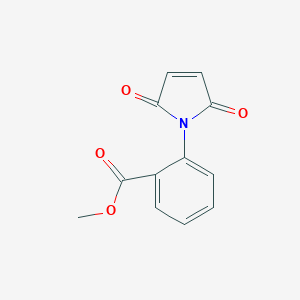
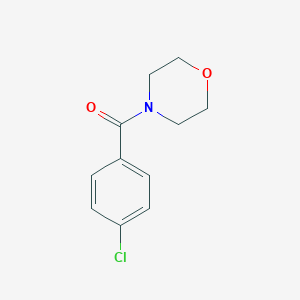
![2-[Bis(2-ethylhexyl)amino]ethanol](/img/structure/B91584.png)
